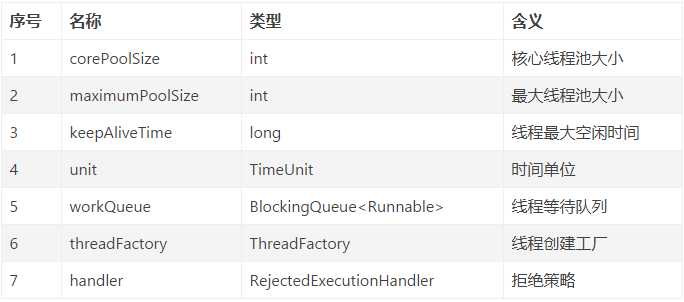在开发项目中通常我们有场景需要开启异步任务。比如在用户注册成功时,需要发放一些优惠券。此时为了不让这些额外的操作影响用户的注册流程,我们通常开启一个线程异步去执行发放优惠券逻辑。
通常我们需要自己定义一个线程池,开启一个线程任务。在Springboot中对其进行了简化处理,自动配置一个 org.springframework.core.task.TaskExecutor类型任务线程池,当我们开启@EnableAsync注解时,在需要执行异步任务的方法添加@Async注解时,该方法自动会开启一个线程去执行。
在讲解Springboot如何配置开启异步任务时,我们先简单说明下Java的线程池有关的基本知识。
线程池基本知识
使用线程池场景
通常高并发,任务执行时间短的业务创建线程的时间是T1,执行任务的时间是T2,销毁线程的时间是T3,当T1+T2的时间远远大于T2则可以采用线程池,线程池的作用核心在于复用线程,减少线程的创建与销毁的时间开销。
方便的统计任务的执行信息,例如完成的任务数量。
Executor线程池的顶级接口
Jdk1.5版本以后,便提供线程池供开发人员方便的创建自己的多线程任务。java.util.concurrent.Executor接口为线程池的顶级接口。
该接口execute接收一个Runnable线程实例用来执行一个任务。
public interface Executor {
void execute(Runnable command);
}
ExecutorService接口详解
public interface ExecutorService extends Executor {
/**关闭线程池不会接收新的任务,内部正在跑的任务和队列里等待的任务,会执行完
*/
void shutdown();
/**
* 关闭线程池,不会接收新的任务
* 尝试将正在跑的任务interrupt中断
* 忽略队列里等待的任务
* 返回未执行的任务列表
*/
List<Runnable> shutdownNow();
/**
* 返回线程池是否被关闭
*/
boolean isShutdown();
/**
*线程池的任务线程是否被中断
*/
boolean isTerminated();
/**
*接收timeout和TimeUnit两个参数,用于设定超时时间及单位。
* 当等待超过设定时间时,会监测ExecutorService是否已经关闭,若关闭则返回true,否则返回false。和shutdown方法组合使用。
*/
boolean awaitTermination(long timeout, TimeUnit unit)
throws InterruptedException;
/**
* 提交任务会获取线程的执行结果
*/
<T> Future<T> submit(Callable<T> task);
/**
* 提交任务会获取线程的T类型的执行结果
*/
<T> Future<T> submit(Runnable task, T result);
/**
* 提交任务
*/
Future<?> submit(Runnable task);
/**
* 批量提交返回任务执行结果
*/
<T> List<Future<T>> invokeAll(Collection<? extends Callable<T>> tasks)
throws InterruptedException;
/**
* 批量提交返回任务执行结果
*增加了超时时间控制,这里的超时时间是针对的所有tasks,而不是单个task的超时时间。
*如果超时,会取消没有执行完的所有任务,并抛出超时异常
*/
<T> List<Future<T>> invokeAll(Collection<? extends Callable<T>> tasks,
long timeout, TimeUnit unit)
throws InterruptedException;
/**
* 取得第一个方法的返回值,当第一个任务结束后,会调用interrupt方法中断其它任务
*/
<T> T invokeAny(Collection<? extends Callable<T>> tasks)
throws InterruptedException, ExecutionException;
/**
* 取得第一个方法的返回值,当第一个任务结束后,会调用interrupt方法中断其它任务
* 任务执行超时抛出异常
*/
<T> T invokeAny(Collection<? extends Callable<T>> tasks,
long timeout, TimeUnit unit)
throws InterruptedException, ExecutionException, TimeoutException;
}
ThreadPoolExecutor参数解析
ThreadPoolExecutor 是用来处理异步任务的一个接口,可以将其理解成为一个线程池和一个任务队列,提交到 ExecutorService 对象的任务会被放入任务队或者直接被线程池中的线程执行并且ThreadPoolExecutor 支持通过调整构造参数来配置不同的任务处理策略。
下面贴出ThreadPoolExecutor线程池构造函数代码:
public ThreadPoolExecutor(int corePoolSize,
int maximumPoolSize,
long keepAliveTime,
TimeUnit unit,
BlockingQueue<Runnable> workQueue,
ThreadFactory threadFactory,
RejectedExecutionHandler handler) {
if (corePoolSize < 0 ||
maximumPoolSize <= 0 ||
maximumPoolSize < corePoolSize ||
keepAliveTime < 0)
throw new IllegalArgumentException();
if (workQueue == null || threadFactory == null || handler == null)
throw new NullPointerException();
this.acc = System.getSecurityManager() == null ?
null :
AccessController.getContext();
this.corePoolSize = corePoolSize;
this.maximumPoolSize = maximumPoolSize;
this.workQueue = workQueue;
this.keepAliveTime = unit.toNanos(keepAliveTime);
this.threadFactory = threadFactory;
this.handler = handler;
}
ThreadPoolExecutor每个入参含义:

参数之间的关系:
- 从线程池中获取可用线程执行任务,如果没有可用线程则使用ThreadFactory创建新的线程,直到线程数达到corePoolSize限制
- 线程池线程数达到corePoolSize以后,新的任务将被放入队列,直到队列不能再容纳更多的任务
- 当队列不能再容纳更多的任务以后,会创建新的线程,直到线程数达到maxinumPoolSize限制
- 线程数达到maxinumPoolSize限制以后新任务会被拒绝执行,调用 RejectedExecutionHandler 进行处理

RejectedExecutionHandler拒绝策略
1、AbortPolicy:直接抛出异常,默认策略;
2、CallerRunsPolicy:用调用者所在的线程来执行任务;
3、DiscardOldestPolicy:丢弃阻塞队列中靠最前的任务,并执行当前任务;
4、DiscardPolicy:直接丢弃任务;
ThreadPoolExecutor使用要点
- 合理配置线程池的大小:如果是CPU密集的任务,线程池数量设置为CPU核心数+1即可,如果是IO密集任务,则CPU空闲较多,线程池数量设置为CPU核心数*2
- 任务队列:任务队列一般使用LinkedBlockingQueue指定大小,配合拒绝策略使用,默认是Integer.Max_VALUE容易内存溢出。
- 任务异常: 线程池中任务注意上加上try{}catch{}捕获异常,方便排查问题
SpringBoot线程池
org.springframework.core.task.TaskExecutor为Spring异步线程池的接口类,其实质是java.util.concurrent.Executor。


springboot2.3.x默认使用的线程池就是ThreadPoolTaskExecutor,可以通过TaskExecutionProperties进行简单的参数调整

SpringBoot定义自己的异步线程池
@EnableAsync
@Component
@Slf4j
public class AsyncConfig implements AsyncConfigurer {
public TaskExecutor taskExecutor() {
ThreadPoolTaskExecutor executor = new ThreadPoolTaskExecutor();
// 设置核心线程数
executor.setCorePoolSize(8);
// 设置最大线程数
executor.setMaxPoolSize(16);
// 设置队列容量
executor.setQueueCapacity(50);
// 设置线程活跃时间(秒)
executor.setKeepAliveSeconds(60);
//设置线程池中任务的等待时间,如果超过这个时候还没有销毁就强制销毁,以确保应用最后能够被关闭,而不是阻塞住
executor.setAwaitTerminationSeconds(60);
// 设置默认线程名称
executor.setThreadNamePrefix("CodehomeAsyncTask-");
// 设置拒绝策略
executor.setRejectedExecutionHandler(new ThreadPoolExecutor.CallerRunsPolicy());
// 等待所有任务结束后再关闭线程池
executor.setWaitForTasksToCompleteOnShutdown(true);
executor.initialize();
return executor;
}
public Executor getAsyncExecutor() {
return taskExecutor();
}
public AsyncUncaughtExceptionHandler getAsyncUncaughtExceptionHandler() {
return new MyAsyncExceptionHandler();
}
/**
* 自定义异常处理类
*/
class MyAsyncExceptionHandler implements AsyncUncaughtExceptionHandler {
@Override
public void handleUncaughtException(Throwable throwable, Method method, Object... objects) {
log.info("Exception message - " + throwable.getMessage());
log.info("Method name - " + method.getName());
for (Object param : objects) {
log.info("Parameter value - " + param);
}
}
}
}
两种使用方法
@Component
@Slf4j
public class UserServiceSyncTask {
//不带返回值
@Async
public void sendEmail(){
try {
TimeUnit.SECONDS.sleep(1);
} catch (InterruptedException e) {
e.printStackTrace();
}
log.info(Thread.currentThread().getName());
}
//带返回值
@Async
public Future<String> echo(String msg){
try {
Thread.sleep(5000);
return new AsyncResult<String>(Thread.currentThread().getName()+"hello world !!!!");
} catch (InterruptedException e) {
//
}
return null;
}
}
千里之行,始于足下。这里是SpringBoot教程系列第十篇,所有项目源码均可以在我的GitHub上面下载源码。